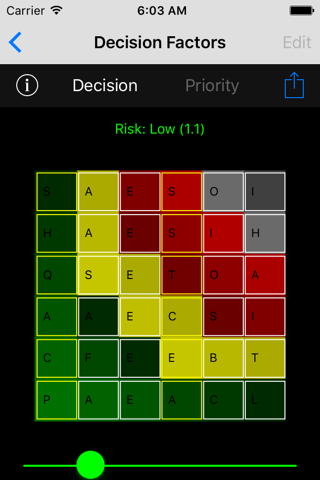
BetterAtLife app for iPhone and iPad
Developer: MyndScope
First release : 04 May 2015
App size: 17.94 Mb
Greater mental accuracy results in a higher quality of life
The ratio between the doing, feeling and thinking parts of our minds indicates the center of our attention. The technique is called ternary analysis. The center of attention can be diagrammed by drawing lines from the three vertices of a triangle. The angle of the lines is determined by the ratios. Each line represents a spectrum of differences. The point where the three lines intersect represents the center of our attention.
The shades of doing, feeling and thinking is analogous to the familiar color wheel tool used to select a color. The color wheel is a ternary tool, because all colors choices are derived from a blend of pure red (doing), feeling (green) and blue (thinking). The permutations of three primary colors results in millions of color shades.
The most concrete way to understand the ternary reasoning process is by breaking down a familiar movie script. Rick is the protagonist in the 1942 movie Casablanca that illustrates the concept of ternary logic. The movie script was made public and is not copyrighted. The script provides a concrete point of discussion that some people might remember.
Rick faced a trilemma about his married lover, Ilsa. A trilemma is a dilemma with three, rather than two, dimensions. Rick faced three choices. Rick’s first choice was to escape Casablanca with Ilsa. Rick knew that Ilsa would eventually regret leaving her husband. Rick decided to help Isla and her husband escape Nazi persecution by giving them the valuable exit visas. Rick’s third problem is how to avoid Nazi persecution as a consequence of assisting Ilsa.
The movie continuously prompts us to decide whether Rick is a sentimentalist, cynic or realist. Please see the first screenshot. Rick is an ambiguous character, because the movie displays all three types of Rick’s thinking. The movie script makes clear that Rick falls somewhere along the spectrum of all three types of thinking. Rick’s final decision probably lies at the realism end of the spectrum.
Rick’s life experiences are represented by the 36 scenes in the movie. Each scene in Casablanca represents a shade of Rick’s mental state.
Ternary analysis is the technique that allows us to analyze snapshots of life. First, the information in a movie script is abstracted as a hierarchical information tree. Please see the second screenshot. The scenes of a movie represents information branches. An information branch is broken down into information twigs and leaves. A dialog can be considered an information twig. Individual sentences represent information leaves.
To apply ternary analysis to a movie you might pick the most important 25 to 50 information leaves. Add each leaf to the three movie trees. A specific technique called Universal Rating is applied to each leaf to determine whether the leaf passes a certain threshold. Please see the third screenshot. The leaves that pass the threshold are used to pinpoint an exact location inside the triangle. My personal ternary analysis of Casablanca references 37 lines, or leaves in the Casablanca script. Rick’s personality confused me for most of my life, because Rick is portrayed in ambiguous terms. I became very clear about Rick’s character, after performing a ternary analysis.
The ternary technique can be applied to a wide variety situations in our daily lives. I also use the technique to evaluate products. Please see the fourth screenshot.
The ternary process is an implementation of philosophy, or more exactly mathematical psychology. Compromises are easier to accept when philosophy guides their resolution. Please see the fifth screenshot.
Please visit https://questionofjudgment.com/ for greater detail.



